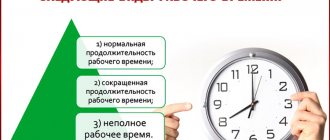If you work in a construction and installation organization, in transport, in a manufacturing or catering enterprise, in a retail store, gas station, pharmacy, fitness club, in the entertainment industry or in a company with 24-hour operation, then you are well aware of the fact that that it is impossible to complete all the tasks facing your organization within the 8 hours a day and 40 hours a week “allotted” by the Labor Code of the Russian Federation. What to do in such conditions? The law offers a way out - to introduce summarized recording of working hours. The procedure for maintaining such records and remuneration of employees raise many questions in practice. The answers to them are in our article.
Part 4 art. 91 of the Labor Code of the Russian Federation provides for the employer’s obligation to keep records of the time actually worked by each employee. Depending on the specifics of work in the organization, you can keep daily, weekly or summarized records of working time.
Note! Summarized accounting is a special procedure for distributing and accounting for working time and rest time, based on work schedules (shift schedules)
In cases where the organization as a whole or when performing certain types of work cannot comply with the daily or weekly working hours established for a given category of employees, it is permissible to introduce summarized recording of working hours so that the duration of work during the accounting period does not exceed the normal number of working hours (Part 1 of Article 104 of the Labor Code of the Russian Federation). In this case, the accounting period cannot exceed one year.
SCOPE OF APPLICATION
Summarized accounting can be established both for employees working under normal working hours, and for employees working part-time (shift) and (or) part-time, as well as for employees who have reduced working hours. As a rule, summarized accounting is used for shift work or flexible working hours.
It should be taken into account that, without fail, the summarized recording of working time is applied only when working on a rotational basis (Article 300 of the Labor Code of the Russian Federation).
Documenting
The basic document for the application and regulation of summary accounting is the act adopted by the enterprise.
The document must contain the following conditions:
- Duration of work shift.
- The beginning and end of the working day.
- Lunch break time.
- Shift rotation order.
The act specifies other conditions that allow organizing shift work, for example, the number of shifts per day.
An example of a local regulatory act enshrining these provisions:
Regulations on summarized recording of working time
An example of an order that introduces provisions on summarized accounting into local acts of an enterprise:
An example of introducing summarized accounting into internal regulations
How to indicate it in an employment contract?
If there is a special labor regime, a short wording is included in the contract.
A sample employment contract (on summarized recording of working time) is presented in a similar version:
“The employee is given a work and rest schedule in shifts – 2 working days, 2 days off. The duration of the shift, its beginning and end, the number of shift hours, lunch breaks, and the sequence are established according to the schedule. The shift work plan is approved before the beginning of the month. A summarized recording of working time is introduced for the employee with a recording frequency of 1 month.”
Sample text of provisions for summarized recording of working time in an employment contract:
STANDARD WORKING TIME AND ACCOUNTING PERIOD
Important! When summed up within the selected accounting period, the total working hours should not exceed the normal number of working hours for this period
The peculiarity of summarized accounting is that the duration of working hours per day and during the week is allowed to deviate from that established for this category of workers. In this case, overtime on some days (weeks) is “compensated” by underwork on other days (weeks) so that within the selected accounting period the total working time does not exceed the normal number of working hours for this period for the corresponding category of workers (Part 1 and 2, Article 104 of the Labor Code of the Russian Federation).
At the same time, fulfillment of the labor standard - working out the normal number of working hours - is ensured not in a week, but over a longer period of time - the accounting period.
Next year, in certain structural divisions of our organization, summarized recording of working hours will be introduced. What should you do first?
To introduce a summarized accounting of working time in an organization, first of all, you need to select an accounting period - a month, a quarter or another period of up to one year - and calculate the normal number of working hours in it (Part 2 of Article 104 of the Labor Code of the Russian Federation). This is necessary for the correct calculation of hours worked by an employee overtime and subject to appropriate payment (Part 1 of Article 104 of the Labor Code of the Russian Federation, letter of the Ministry of Health and Social Development of Russia dated August 31, 2009 No. 22-2-3363).
At the same time, for employees working part-time (shortened) working hours (shifts) and (or) part-time (shortened) working weeks, the normal number of working hours for the accounting period is correspondingly reduced (Part 2 of Article 104 of the Labor Code of the Russian Federation).
How is the standard working time calculated for a month, quarter U and year?
The standard working time for a month, quarter, year is calculated in accordance with the Procedure for calculating the standard working time for certain calendar periods of time (month, quarter, year) depending on the established duration of working time per week, approved. by order of the Ministry of Health and Social Development of Russia dated August 13, 2009 No. 588n. For ease of use, the already calculated standards are given in the production calendar for each calendar year.
The difficulty of working under conditions of summarized working time tracking is that you have to periodically adjust its schedule.
Article 104 of the Labor Code of the Russian Federation. Summarized working time recording (current edition)
1. Summarized recording of working time is used in cases where it is impossible to maintain daily or weekly working hours for a given category of employees. Most often, summarized working time recording is used in continuously operating organizations. At the same time, it can also be used when performing individual jobs.
2. The employer is obliged to keep records of working hours. Keeping track of employees' working hours provides an opportunity not only to monitor compliance with labor discipline, but also to pay employees on time and correctly.
3. The legislator distinguishes between daily, weekly and summarized accounting. The type of working time recording used depends on: the nature of production, the field of activity, the established work schedule, the employee’s labor function and other factors.
4. The accounting period for daily recording of working hours is equal to a working day, and its duration, established in the appropriate manner, is fully worked out on the same working day.
Weekly recording of working time involves an accounting period equal to a week, during which the duration of the working week established by labor legislation must be observed (Articles 91 and 92 of the Labor Code).
When recording working hours together, the accounting period of working time exceeds a week. The total working hours should not exceed the normal number of working hours for this period. Let us recall that normal working hours cannot exceed 40 hours per week, and shortened working hours cannot exceed 24, 35 or 36 hours per week (Articles 91 and 92 of the Labor Code).
When working part-time, the accounting period is based on the length of the working week determined by the parties to the employment contract.
Order of the Ministry of Health and Social Development of Russia dated August 13, 2009 N 588n approved the Procedure for calculating the standard working time for certain calendar periods of time (month, quarter, year) depending on the established duration of working time per week.
6. When recording working hours in aggregate, the duration of the working week established by law is ensured by the schedule on average for the accounting period. The daily and weekly working hours established by the schedule may deviate to a certain extent from the established standard working hours. Any deficiencies (overwork) that appear must be corrected within the established accounting period. The number of working hours according to the schedule must be equal to the number of working hours according to the established norm for this period.
7. Accounting periods can be a month, a quarter, a half-year and other periods. The maximum accounting period is one year.
Thus, crop production workers in agricultural organizations, including tractor driver operators, may be provided with a summary record of working time for an annual accounting period (calendar or billing year). For workers, repair shops, vehicles, warehouses and other departments serving crop production, summarized accounting of working time can be established for individual periods of intense field work (Methodological recommendations for accounting of labor costs and their payment in agricultural organizations, approved by the Ministry of Agriculture of Russia on October 22, 2008 ).
The main requirement: the duration of working hours during the accounting period should not exceed the normal number of working hours.
In order to protect the health of workers engaged in work with harmful and (or) dangerous working conditions, Federal Law dated December 28, 2013 N 421-FZ established for them a maximum accounting period of 3 months when recording working hours in aggregate.
Classification of working conditions as harmful (class 3) and dangerous (class 4) is determined by paragraphs 4, 5 of Art. 14 of the Law on special assessment of working conditions.
8. For some categories of employees, special accounting periods are established. The Regulations on the peculiarities of the regime of working time and rest time, working conditions of certain categories of railway transport workers directly related to the movement of trains, determine that the working time of workers whose permanent work is carried out on the road: workers of train crews of passenger trains, workers of refrigerated sections and ARVE, hopper-dispenser and dumpcar routes, articulated transport cars, service cars, baggage cars and dispensing cars - with a total round trip duration of three days or more can be calculated as a tour (the accounting period from the moment the employee reports to work for the trip until the time he reports employee to work for the next trip, after his rest at the point of permanent work).
9. When recording working hours in aggregate, work in excess of the normal number of working hours during the accounting period is overtime work (see Article 99 of the Labor Code and commentary thereto).
10. The procedure for introducing summarized working hours is established by a local regulatory act - internal labor regulations, which are approved by the employer taking into account the opinion of the representative body of employees.
Regulation of the summarized recording of working time by internal labor regulations involves fixing in them:
— categories of employees in respect of whom summarized recording of working time is applied;
— duration of the accounting period;
— maximum duration of a work shift, etc. The maximum duration of a work shift with cumulative accounting of working hours is not limited by labor legislation. In practice it is 10 - 12 hours.
11. On the establishment of summarized accounting of working time when working on a rotational basis, see Art. 300 TK.
12. For some categories of employees, the use of summarized recording of working time is established by the by-laws of ministries and other federal executive authorities. Thus, the Regulations on the peculiarities of the working time and rest time regime for floating crew members of inland water transport vessels provide for the establishment of a summarized accounting of working time for floating crew workers, while the accounting period should not exceed one year (from the beginning of navigation to the beginning of the next navigation).
The Regulations on the Peculiarities of Working Hours and Rest Time for Crew Members (civilian Personnel) of Support Vessels of the Armed Forces of the Russian Federation establishes a summarized accounting of working time for ship crew members, taking into account the fact that the maximum duration of work for ship crew members between two periods of rest ashore (staying in vacation, use of accumulated rest days) should not exceed 120 calendar days. When performing work on long voyages, the duration of work on a ship for crew members or individual crew members can be increased to 150 calendar days.
The Regulations on the peculiarities of working time and rest time for certain categories of workers in the fishery complex, who have a special nature of work, define: during the period of operation of fishing vessels and the work of members of fishing crews (artels), summarized recording of working time is introduced.
The regulations on the peculiarities of working hours and rest time, working conditions for certain categories of railway transport workers directly related to the movement of trains establish: for employees of railway transport organizations where the duration of the production process exceeds the permissible duration of daily work (shift) for workers whose work takes place in shifts (but not around the clock), as well as for workers with a divided working day, a summarized recording of working time is established for a six-day working week with one day off and working on four-shift work schedules with a 12-hour duration. The length of shifts at night is not reduced.
The Regulations on the Peculiarities of Working Time and Rest Time for Car Drivers stipulate that in cases where, due to production (work) conditions, the established normal daily or weekly working hours cannot be observed, drivers are provided with a summarized recording of working time with a recording period of one month. For the transportation of passengers in resort areas in the summer-autumn period and for other transportation associated with servicing seasonal work, the accounting period can be set to last up to six months.
The Regulations on the Peculiarities of Working Time and Rest Time for Metro Workers establishes: it is allowed to introduce summarized recording of working time for periods of one to three months; for employees of personnel of recovery trains (emergency recovery formation), a summarized recording of working time should be established; when recording working hours in aggregate, the maximum permissible duration of daily work (shift) of employees, with the exception of drivers and assistant drivers of electric trains working on the line, cannot exceed 12 hours; when accounting for working hours in total, overtime work should not exceed 24 hours per month and 120 hours per year for each employee.
Comment source:
Rep. ed. Yu.P. Orlovsky “COMMENTARY ON THE LABOR CODE OF THE RUSSIAN FEDERATION”, 6th edition ACTUALIZATION
ORLOVSKY Y.P., CHIKANOVA L.A., NURTDINOVA A.F., KORSHUNOVA T.YU., SEREGINA L.V., GAVRILINA A.K., BOCHARNIKOVA M.A., VINOGRADOVA Z.D., 2014
By the way
| The normal working hours, i.e. the time during which an employee must perform work duties, is no more than 40 hours per week. For some categories of workers, normal working hours are reduced. These are minor workers, disabled people of groups I and II, as well as workers engaged in work with harmful or dangerous working conditions, etc. For them, the normal working time can be, for example, 24, 35 or 36 hours a week (Article 91 and 92 Labor Code of the Russian Federation). |
If an employee was sick in the month of the accounting period in which the shortfall occurs, and overtime in other months of the accounting period was not “paid off,” it is necessary to adjust the work schedule by providing additional hours or days of rest in order to reach the standard working hours at the end of the accounting period.
At our gas station, all operators have a summarized recording of working hours with an accounting period of a quarter. According to the work schedule, in one month the operators are overworked, in another, on the contrary, there is a shortfall in the working hours. Is it necessary to revise the work schedule in this case?
The monthly standard working time according to the schedule quite often differs from the monthly standard duration according to the production calendar. The main condition: the normal number of working hours per quarter must correspond to the normal working hours according to the work schedule of gas station operators for the accounting period (quarter).
Overtime or shortfall of normal working hours by these employees in a particular month will not serve as a basis for revising the work schedule if the total working time corresponds to the established standard hours during the accounting period (quarter).
Subject of the agreement
1.1. Under this employment contract, the Employee undertakes to fulfill the duties of his profession/position [indicate work by position in accordance with the staffing table, profession, specialty indicating qualifications; specific type of work entrusted to the employee] at [place of work, and in the case where the employee is hired to work in a branch, representative office or other separate structural unit of the organization located in another locality, the place of work indicating the separate structural unit and its location], and The Employer undertakes to provide the Employee with the necessary working conditions provided for by labor legislation, as well as timely and full payment of wages.
1.2. Work under this agreement is the main place of work for the Employee.
1.3. Working conditions in the workplace in terms of the degree of harmfulness and (or) danger are [optimal (class 1)/permissible (class 2)/harmful (specify the class and subclass of harmfulness)/hazardous (class 4)].
1.4. The probationary period for hiring is [specify the period]./The employee is hired without a probationary period.
1.5. The employment contract is concluded for an indefinite period.
1.6. The employee must begin work on [day, month, year].
back to contents
WORK SCHEDULE (Shifts)
Work schedules (shifts) are drawn up for different periods of time. When using summarized working time recording, a schedule can be drawn up for the accounting period. The Labor Code of the Russian Federation contains a rule regulating the period for bringing the schedule to the attention of employees, but not the period for which it should be drawn up.
When drawing up a work schedule (shift), the employer must comply with the following rules.
Rule 1. The number of allocated hours of work cannot exceed the normal number of working hours for the accounting period.
Rule 2. Working for two shifts in a row (even with the consent of the employee) is prohibited (Part 5 of Article 103 of the Labor Code of the Russian Federation).
Rule 3. The duration of daily (between shifts) rest must be enshrined in a local regulatory act or determined by a collective agreement, as well as in shift schedules (Article 107 of the Labor Code of the Russian Federation).
At the same time, for some operating modes, rest between shifts may be established by separate legal acts.
With a rotational method of organizing work, the duration of daily (between shifts) rest for workers, taking into account lunch breaks, can be reduced to 12 hours. The hours of rest that are underused in this case, as well as the days of weekly rest, are summed up and provided in the form of additional days free from work (days of inter-shift rest) during the accounting period (clause 4.3 of the Basic Provisions on the Shift Method of Organization of Work, approved by the Resolution of the USSR State Committee for Labor, the Secretariat All-Union Central Council of Trade Unions, Ministry of Health of the USSR dated December 31, 1987 No. 794/33-82; hereinafter referred to as the Regulations on the rotation method).
Rule 4. Duration of weekly rest established by Art. 110 of the Labor Code of the Russian Federation (at least 42 hours weekly), must be observed on average for the accounting period.
Rule 5. If more than half of the shift time falls at night, then, as a general rule, its duration is reduced by one hour without further work (Part 2 of Article 96 of the Labor Code of the Russian Federation).
Rule 6. The maximum duration of a work shift is legally established only for certain categories of workers.
The duration of work of certain categories of railway transport workers directly related to the movement of trains is established by Order No. 7 of the Ministry of Railways of Russia dated 03/05/2004 “On approval of the Regulations on the peculiarities of the regime of working time and rest time, working conditions of certain categories of railway transport workers directly related to the movement of trains” "
In practice, it is usually 10-12 hours.
Rule 7. Shifts of employees are counted minus hours worked overtime.
Rule 8. It is necessary to take into account categories of workers for whom a special working day (shift) is established, as well as workers with reduced working hours (Article 94 of the Labor Code of the Russian Federation).
When drawing up such a schedule, the employer should also take into account that an indispensable condition for maintaining and increasing the performance of employees is to establish an optimal alternation of work and rest time for specific conditions. In this regard, schedules should include:
1) compliance with the operating mode of the production site, structural unit in time (accepted number of work shifts, established duration of the working day and working week);
2) correct alternation of work days and rest days;
3) correct shift rotation;
It is known that night work is less productive and, if it is permanent, is harmful to health. Therefore, there is a need to rotate work for individual workers on shifts. The movement of workers from one shift to another is called shift breaking. Shift breaking can take place in ascending order - from the third shift to the second, from the second to the first, from the first to the third; and in descending order - from the first shift to the second, from the second to the third, from the third to the first. It is most advisable to break shifts after a day off.
4) maintaining a constant number of adjacent brigade units on the same shifts. Planned shift assignments are usually constant, therefore, to ensure their implementation, it is desirable to maintain a constant numerical composition of brigade units in the same shifts;
5) maintaining a constant staffing of the brigade on the same shifts. This ensures greater coordination of the brigade's actions and, as a result, higher productivity than with a changing composition.
Work schedules (shifts) can be classified according to characteristics (Table 1).
Table 1
Classification of work schedules (shifts)
The shift schedule when organizing work on a rotational basis has certain features.
Working time and rest time within the accounting period are regulated by the shift schedule for work on shifts (Article 103, Part 1 of Article 301 of the Labor Code of the Russian Federation). When drawing up this schedule, one must remember (in addition to the general rules for drawing up the schedule set out above) about its specific features during the rotation method.
Feature 1. Working hours do not include days spent traveling to and from work. These days may fall on days of inter-shift rest (Part 2 of Article 301 of the Labor Code of the Russian Federation).
Feature 2. The duration of daily work (shift) cannot exceed 12 hours (clause 4.2 of the Regulations on the rotation method).
Feature 3. The duration of daily (between shifts) rest, taking into account lunch breaks, can be reduced to 12 hours (clause 4.3 of the Regulations on the rotation method).
Feature 4. The number of days off (days of weekly continuous rest) in the current month must be at least the number of full weeks of this month (clause 4.3 of the Regulations on the rotation method), i.e., at least four days off per month.
Feature 5. Weekends are determined by the shift schedule. Moreover, the rule that the duration of weekly continuous rest cannot be less than 42 hours, provided for in Art. 110 of the Labor Code of the Russian Federation does not apply to workers working on a rotational basis (part 3 of Article 301 of the Labor Code of the Russian Federation and clause 4.3 of the Regulations on the rotational method).
Feature 6. According to Part 1 of Art. 301 of the Labor Code of the Russian Federation, the shift schedule is brought to the attention of workers no later than two months before it comes into effect (and not one month, as follows from the general rule of Part 4 of Article 103 of the Labor Code of the Russian Federation).
The organization of work on a rotational basis obliges the employer to maintain several types of records (Table 2).
table 2
Types of recording working time and time spent by workers on shift
Holidays and weekends
In order to correctly process wages on holidays and weekends, you need to determine whether the holiday is a scheduled working day or a weekend. If this is a working holiday, then it is reflected in the timesheet as “I” - Attendance (not reflected as PB), and the minimum additional payment for this day must be made in a single amount, since there are no special deviations for summarized accounting in Article 153 of the Labor Code of the Russian Federation provided. That is, the employee, provided he works a full schedule, will receive his salary (if paid according to salary) and an additional payment in the amount of a single rate for a holiday. If this is a non-working holiday, then it is reflected in the timesheet as “RV”, and the minimum additional payment for this day must be made, as a general rule, no less than double the amount in the current month. In this case, the employee will receive his salary (if paid according to salary) and an additional payment in the amount of double the rate for the holiday. When calculating overtime hours based on the results of the accounting period on holidays, work performed in excess of the norm should not be taken into account, since it has already been paid double (clause 4 of Explanation No. 13/P-21 “On compensation for work on holidays”).
Payment according to average earnings
When calculating average earnings for all cases (except for vacation and sick leave), the average hourly earnings should be calculated (clause 13 of Regulation No. 922 on average earnings). To pay vacation pay and compensation for unused vacations, you also need to calculate the average daily earnings (clauses 4, 9–11 of Regulation No. 922 on average earnings), and to pay temporary disability benefits and child care benefits, in turn, calculate the average daily earnings in general order.
In conclusion, I note that summarized accounting can be established when the daily and (or) weekly working hours determined by law are not observed. The company independently develops schedules and sets the accounting period. When calculating the standard working time for a specific specialist, it is necessary to exclude periods when the employee did not work for valid reasons. Based on these figures, the number of hours worked overtime is determined. Overtime hours are calculated at the end of the accounting period and are subject to payment according to the rules of Article 152 of the Labor Code of the Russian Federation. To pay for unworked hours, you must establish the reason for them and pay in the appropriate amount. Work on a non-working holiday during summed accounting is doubled and is not taken into account when calculating at the end of the accounting period. A working holiday with cumulative accounting is usually paid in a single amount. Payment based on average earnings in the case of summarized accounting is made based on the average hourly rate, except for payment of vacation pay and sick leave.









